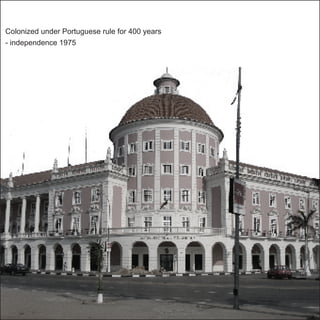
Bakgrunn 1
- 1. Colonized under Portuguese rule for 400 years - independence 1975
- 2. Devastating civil war lasting 27 years - ended 2002
- 3. BEFORE THE WAR, MOST PEOPLE SUPPORTED THEMSELVES BY SMALL-SCALE FARMING
- 4. RURAL AREAS AND FARMLAND ARE MANY PLACES LEFT USELESS, LITTERED BY LAND MINES. IN THE INLANDS, BIG AREAS OF FORMER FARMLANDS ALSO SUFFERS FROM DEGRADATION OF THE FERTILE SOILS
- 5. People migrating to the capital as a result of the civil war - the larger towns and cities were more safe
- 6. Luandas muceques 80 % of the urban population
- 7. Luandas baixa 20 % of the urban population
- 8. Massive construction boom as a result of oil revenues
- 9. Luanda Luanda FORMAL RESIDENTS INFORMAL RESIDENTS 20% 80%
- 10. UN Habitat’s Executive Director Anna Tibaijuka called upon President dos Santos to allocate 10% of Angola’s oil income to upgrading vital social services such as housing, plumbing, clean water and electricity and praised Angola’s stated commitment toward a slum revitalization program. Approximately 85% of Angolans live in slum conditions surrounding major cities. In April 2009, Angola announced the creation of a special fund to build one million houses over the next four years. Three months later in July, three thousand families were forcibly evicted from the Luanda neighborhoods of Iraque and Bagdad, utterly demolishing homes and possessions. “Armed police, soldiers and presidential guards arrived in both neighbourhoods at 3am on 20 July and ordered people out of their homes before bulldozers began to demolish the houses. The residents stood and watched as their homes were being demolished. Some of those who tried to stop the demolitions were beaten.” Since 2001, Amnesty International has documented the forcible eviction of more than 10,000 persons from slum dwellings in Angola, often accompanied by violence including police indiscriminately firing their weapons and beating women and children. Source: Amnesty International
- 11. 1,000,000 houses to be built by 2012 - is to inculde social housing for the poor - has been critisized as being million dollar houses
- 12. Big-scale new social housing projects
- 13. “We face neither East nor West; We face forward” Kwame Nkrumah
- 14. Today’s railways
- 16. Today’s railways reflecting the colonial time’s utilization and exportation of resources. The proposed railway grid reflects A.U.s visions of a more united continent.
- 17. Luanda Railway Benguela Railway Mocamedes Railway
- 18. VEGETATION BROADLEAF EVERGREEN FOREST UNDIFFERENTIATED GRASSLAND AND WOODLAND DECIDUOUS FOREST AND GRASS GRASSLAND SAVANNA BRUSH DESERT
- 19. Luanda - rapid growth in population and size 1980 - 19,42 Km2 1989 - 100,80 Km2 1998 - 253,27 Km2 2000 - 270,05 Km2 2010 - 350,00 Km2
- 20. “We have very little time, so we have to move slowly“ Kwame Nkrumah
- 21. The country continues to face massive developmental challenges including reducing the dependency on oil and diversifying the economy, rebuilding its infrastructure, improving institutional capacity, governance, public financial management systems, human development indicators and the living conditions of the population. (World Bank)
- 22. LUANDA TENTANG LUANDA MUCEQUES VIANA BAIA CATETE ZENZA DO ITOMBE CASSULALA NDALAHUI LUINHA CONHOCA and the 16 railway stops along the way Rehabiliting the 480 km long CFL railway LUCALA N’DALATANDO KIZENGA CAMBUZE CACUSO LOMBE COMBOLO MELANJE
- 23. NEW RAILWAY STATIONS ARE POPPING UP ALONG THE CFL RAILLINE
- 24. WORKING ON BOTH TOP-DOWN AND BOTTOM-UP-STRATEGIES. A SUSTAINABLE SOLUTION DEPENDS ON THE BOTTOM-UP PERSPECTIVES’ INFLUENCE ON THE TOP-DOWN STRATEGIES.
- 25. THE URBAN CORRIDOR (Luanda) DIFFUSE SPATIAL DEVELOPMENT (Railway potential)
- 27. Working in the transition zone in Luanda, from urban corridor towards a ‘diffuse’ development.
- 28. LUANDA TENTANG MACRO ZENZA DO ITOMBE N’DALATANDO MELANJE CASSULALA COMBOLO NDALAHUI CONHOCA CAMBUZE KIZENGA LUANDA CACUSO LUCALA LUINHA CATETE LOMBE VIANA BAIA African Union’s work towards a more united continent Raillines as a part of this program Potential new development MEZO Work towards inclusiveness and community Node thinking in Luanda’s outer areas and growth zones Mezoscale identity MICRO Participation in process Railway station as local generator